

Not that this is standard practice for an introduction course to alpine mountaineering, but then I was climbing the Aiguille Crochues with a group of students from Sweden. And they intended to take a bottle on every peak we climbed that week…… followed a beer in the sauna. Standard practice in Sweden apparently.
Coming from south London, I’d done a far bit of rock climbing, particularly the Southern Sandstone crags around Tunbridge Wells, but very little in the big mountains, so I signed up for a week’s introduction to alpine mountaineering with Action Outdoors in the climbing mecca of Chamonix. Chamonix is home to some of the most extreme climbs in the Alps; the Grandes Jorasses, Les Drus, Les Droites and of course Mont Blanc, but there are also some classic glacier walks and easy alpine accents, like Mont Tondu and Aiguille du Tour that any enthusiastic walker with some specific training or a guide can do.
"Coming from south London, I’d done a far bit of rock climbing, particularly the Southern Sandstone crags around Tunbridge Wells, but very little in the big mountains, so I signed up for a week’s introduction to alpine mountaineering with Action Outdoors in the climbing mecca of Chamonix"
I had initially been a little put off as considered it mountaineering a sport for mostly gnarly old men who took it all very seriously, but meeting the team at the UCPA Building, based right in the heart of Chamonix, I saw immediately that this wasn’t the case. The UCPA’s aim is to make outdoor sports accessible to young people, who may not usually be able to afford a course in mountaineering, without overemphasis on performance, but more a concern for personal development. After settling into our dorm room, we are given all the equipment we needed, such as crampons, ice axes, boot and harnesses and put into groups based on our experience level. My rock climbing experience meant, I was in a slightly higher group as I just needed to refresh skills like walking in crampons, moving as roped partners and using ice axes. Pierre, our tutor for the week, greeted us. Tall and lanky and extremely calm and relaxed, he handed me a booklet to log all we’d learnt and provide us with some basic knowledge and understanding of to be safe in the mountains. The communal living makes it almost feels like being back in the girl guides, with the UCPA providing great canteen meals with food such as chilli and even calamari and, of course, lots of cheese. It’s great fun, with lots of entertainment from our bongo playing chef and piano playing guide and after a day of activity- it was a relief to have it all there ready for you, requiring no effort on your part.
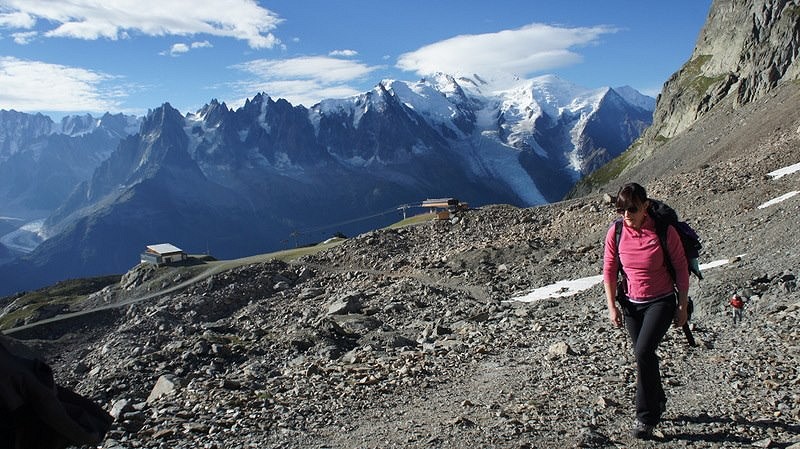
The week turned out to be a superb mix of rock climbing, snow and ice techniques and general travelling in the mountains, which was suitable for the absolute beginner, to those with a little more experience. The first day of the course dawned warm with blue skies, so we went rock climbing at Les Gaillards, just a couple of kilometres away in the direction of Les Houches. The crag near a small pretty lake is a great place to chill out, have a BBQ or set up a slack line. It also has lots of easy routes and very friendly bolting. The first climbs were put up there in the 1930’s with the intention of creating a place where alpinists could learn to climb. At the time the project was considered revolutionary. There are some great single and multi pitch sport climbs here –some shaded and some in the sunshine. Pierre taught us how to set up belays for mutli-pitch routes and although I already knew how to do this, there were several techniques I’d not used before, such as a belaying from an anchor in the rock that’s not directly attached to you, so when you bring up your partner, if they were to fall, you wouldn’t have to hold all their weight yourself. After practicing on some single pitch routes we tucked into our packed lunches provided by the UCPA, then ticked of several multi pitch routes. Hanging off a ledge as my partner climbed up, I looked out over to Mont Blanc glimmering in the sunshine, which was certainly more than enough inspiration for the next few days activities…. and I wondered if one day…maybe…would I ever be able to climb it?
"Hanging off a ledge as my partner climbed up, I looked out over to Mont Blanc glimmering in the sunshine, which was certainly more than enough inspiration for the next few days activities…. and I wondered if one day…maybe…would I ever be able to climb it?"
The next day we put our rock techniques into practice on a multi pitch route on the Aiguille Crochues, (meaning hooked) set in the heart of the Aiguilles Rouge on the north side of the Chamonix Valley. The route follows a sharp ridge that although airy, offers amazing views across to the big peaks to the south. It was chilly as we left the Flegere cable car and ascended on the Index chairlift to 2400 meters, but soon I was dripping in sweat again as we headed up to the base of the climb.
Pierre explained to those in the group who hadn’t used trad gear before how to make the placements, and then we moved off in groups of two. He led first and on any harder sections, hung a knotted rope down for us to pull on if needed. We started making a short traverse across to the access gully at the foot of the Crochues. The climbing, on gneiss rather granite of the Chamonix Aiguilles, whilst interesting, wasn’t too difficult and was a great route for learning to move efficiently on exposed but easy alpine rock terrain. Once we were up the gully the technical climbing began up a short chimney, probably the crux of the route. This led to easier climbing right on the crest and all the way to the summit, climbing over most towers. The route took only a couple of hours, so there was no fraught end of day dash for the last cable car. Pierre explained the techniques in a way that didn’t over complicate details and wasn’t particularly surprised when we reached the top and cracked open a bottle of rouge to celebrate and enjoy the views of the larger peaks of the Mont Blanc Massif.
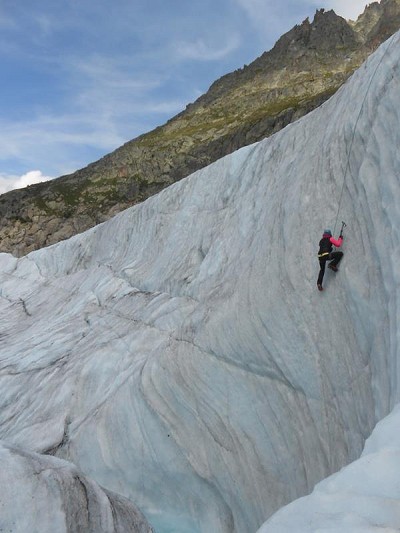
The fine weather continued the next day for ‘ice school’ on the Mer de Glace, (Sea of Ice), where we learnt how to put crampons on, move together across the crevassed terrain and climb the ice of these huge crevasses. Heading up on the Montenvers railway, we climbed down a series of metal ladders to reach the glacier. First we leant different methods to walk in crampons; traversing or going straight up. To traverse we practiced rolling our ankles so that our crampons were flat on the ice and stamped firmly to make sure they stuck. Going straight up was more tiring as we faced directly up the slope, walking in a herringbone step as it steepened to help keep our feet flat. Even more tiring was the "front-pointing" technique, driving the front points of the crampons into the ice.
Pierre then showed us how to set up a belay in the ice by twisting an ice screw into place, and then clip in a karabiner and run the belay rope through the karabiner. He then lowered us down into the crevasse, where one by one we slashed and thrashed our way up the ice with our axes and crampons. My adrenaline really was coursing by this point as it all felt rather tenuous to me… I couldn’t quite trust that the pick would hold me. I certainly could not imagine leading an ice climb...but then we did just that on a slightly easier angled line. We were all pretty euphoric by the time we’d had a few goes and celebrated with more wine on the glacier, admiring views of les Drus (3754 m) and les Grandes Jorasses (4205 m) surrounding us.
Ominously, after a day of relatively warm conditions, it started dribbling with rain as we waited for the Montenvers train to take us back down the valley. After a dinner of BBQ pork and a slide show of the days climbing, Pierre put a notice up for us that we were to be ready to climb the Petite Fourches ( Little Forks at 3520m) the next day and its neighbour, Le Tete Blanche. The peaks aren’t very demanding, but need the right mix of skills to climb so are a good training ground for beginners. But in the morning when we were due to walk to the Albert Premier hut it started chucking it down so we headed to the indoor climbing wall, with its massive overhanging lead wall, in Les Houches, then returned to the UCPA for a session on crevasse rescue.
That afternoon, confident in us, Pierre led us up to the Albert Premier Hut, on the right bank of the Tour glacier. We took the Col de Balme cable car up and made our way as quickly as we could in the rain past the Charamillon lake and the Bec du Picheu until we reached a moraine on the bank of the Tour glacier, where we slowly trudged up to the hut, welcoming a very hearty dinner and an early night.
The next morning dawned with a dusting of snow across the mountains and at 7am (not too early!) we scrambled to get ready and get going on the route. From the hut we walked up the glacier and headed up to the Col du Tour, to the left of the Tête Blanche. In clear weather, we are told, the summits can be easily seen, but now the snow began to fall even harder until we could barely in front of us. Pierre decided it was too risky to try and climb the Petite Fourches, so we made our way to the top of the Tete Blanche, an easy scramble on loose rocks, took what photos we could and retreated back to the hut. This time we waited until we were safely back down in the valley before we popped open a celebratory bottle of wine. All this snow and it was only 31st August!
SUMMARY
Action Outdoors are the UK partners to the French organisation UCPA, a not for profit organisation set up by the French Government to encourage young people into the outdoors (18 - 40 years).It means an introductory course in alpine mountaineering starts from as little as £543 and includes everything required for the week - instruction, equipment, lift passes plus all meals and accommodation. The centre also offers more advanced alpinism courses including summiting Mont Blanc.
For more information visit: http://www.action-outdoors.co.uk/activities/summer/mountaineering

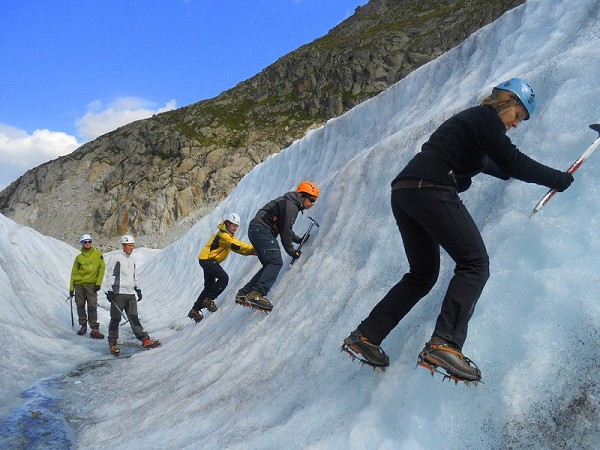

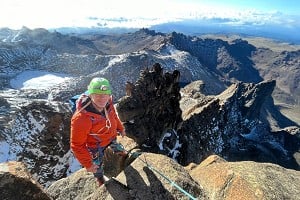
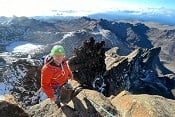
Comments